 At a glance
At a glance
Expert’s Rating
Pros
High performance, especially the graphicsBeautiful OLED screenGood battery lifeWell-built and practical
Cons
Not significantly faster than its predecessorsStill a lot of fan noise
Our Verdict
The new Asus Zenbook 14 OLED has solid battery life and a gorgeous OLED screen. That said, it’s not much faster than its predecessors even with the high-efficiency Intel Core Ultra processor.
Intel just presented its new Meteor Lake processors, and the first laptops with the new circuits will soon be on sale. Luckily, I’ve had the opportunity to test one of them in advance. The Asus Zenbook 14 OLED, with its stunning display and solid graphics performance, has been refreshed both inside and out.
This new model is a thinner and lighter computer than the Asus Zenbook 14 OLED I tested last spring as well as an updated model with the 13th generation Core processor that had the same design and almost the same weight of a little over three pounds. Now we get down to 1.5cm thickness and a weight of between 2.64 and 2.82 pounds, depending on whether the model has a touchscreen or not. Mine has a touchscreen, but I can’t say the extra grams bother me much. For a 14-incher, this is really nice.
Looking for more options? Check out PCWorld’s roundup of the best laptops available right now.
Asus Zenbook 14 OLED: Build quality, keyboard
The Asus Zenbook 14 OLED features a solid, quality build. It’s almost entirely made of matte aluminum, except for the glass screen surface and plastic keyboard keys. The deliciously deep blue-green tones of the surfaces give the computer a professional and luxurious look. With the right rounding of the edges on the underside, the computer is comfortable to hold and carry around, despite a more angular grip on the screen lid.
The keyboard is top-notch with just the right amount of travel and response from the large keys. My only complaint is that the arrow keys are a bit cramped, but that’s almost always the case on small laptops without a numeric keypad. The mouse pad underneath has high precision and excellent direct response for pointing, swiping, and gesturing. It has a wide surface, but is not optimally high.
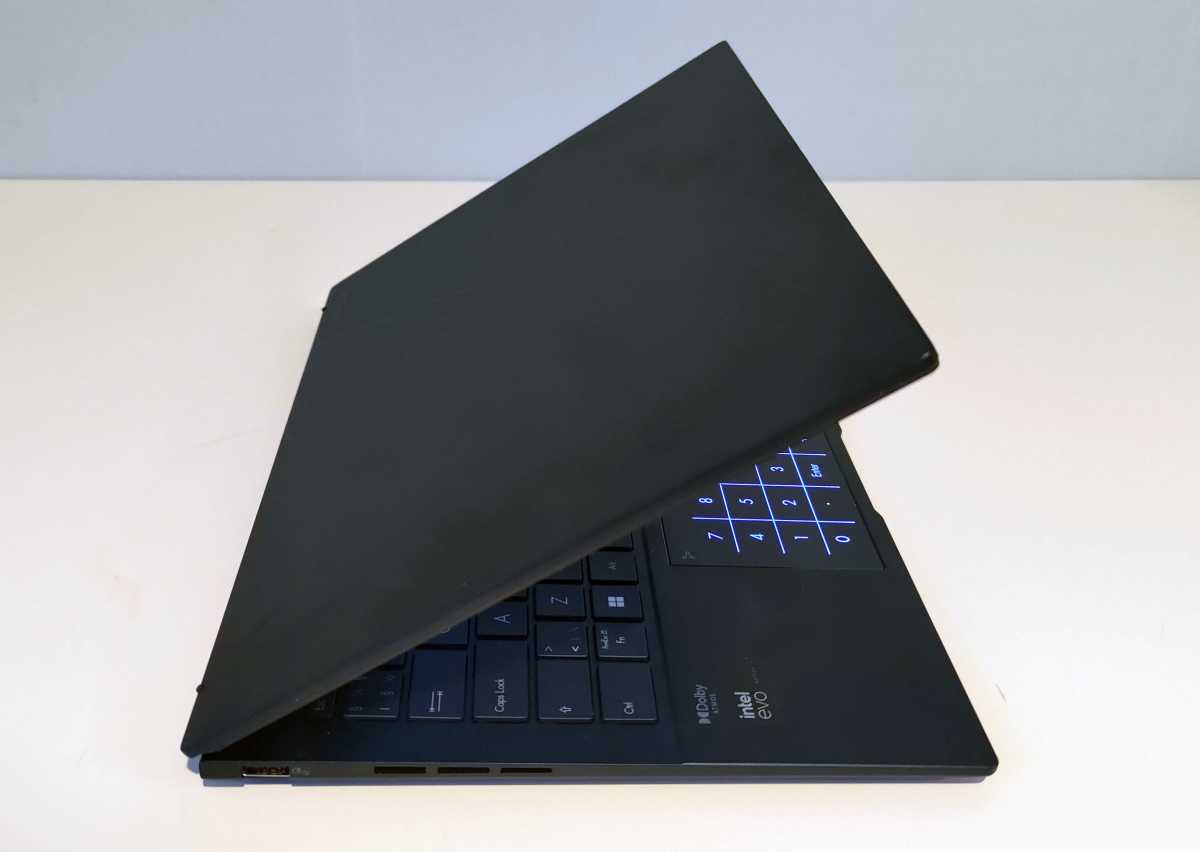 A USB-A on one side.
A USB-A on one side.
Mattias Inghe
Asus Zenbook 14 OLED: Touchpad, ports
A long press in the upper right corner of the mouse pad lights up a numeric keypad on the surface and a press in the other corner lets you adjust its brightness. It’s a viable alternative to a real numeric keypad on the side, especially if you’ve connected an external mouse. It’s possible to use the mouse pad for mouse control and numeric keys at the same time, but this can sometimes cause confusion.
On the sides you’ll find a well-approved set of external connections for a thin laptop. Dual thunderbolt 4 ports with USB-C connector, where you can connect power, external accessories and monitors. Then a separate USB-A with USB-3 speed, a 3.5 mm headset jack, and a full-size HDMI 2.1 port.
It won’t be long before you run out of things to connect to unless you’ve got an external mouse with a USB-A connector. You may also have to invest in a USB-C docking station if you want to bring in more gadgets. You connect to the network wirelessly with Wi-Fi 6e or simpler. We’re still waiting for Wi-Fi 7 laptops, and I had the hope that it would come with this generation of Intel’s processors, but it will take a little longer. In any case, it’s undoubtedly fast enough against the Wi-Fi 6 router I have available for testing.
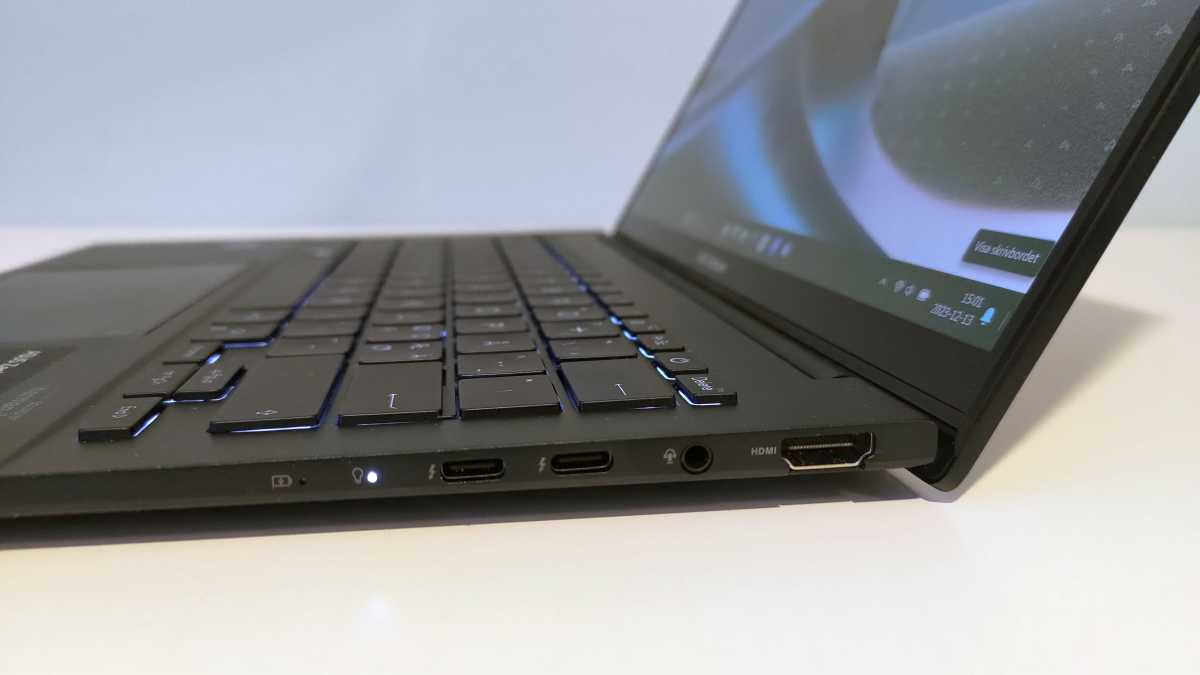 The rest of the connections on the other side.
The rest of the connections on the other side.
Mattias Inghe
Asus Zenbook 14 OLED: Bright OLED screen
Asus has a wider range of OLED laptops than any other manufacturer right now, and the OLED screen here is nothing to sneeze at. The 2880×1800 resolution makes it razor sharp and feel pixel-free at arms length. The contrast is, of course, 100 percent and you get high brightness of up to 400 cd/m2 in type brightness and up to 550 cd/m2 in HDR mode.
The screen is certified for Vesa Display HDR 600 True Black, and with the right image source or HDR-compatible games in the right mode, it can be an intense experience. With 100% coverage of the dci-p3 color scale, you get intense and saturated colors. You have four predefined color profiles to choose from: srgb, pci-p3, display p3, and Native, which seems to produce deeper blues.
It’s not a real professional monitor with extra careful factory calibration of color correctness, but you can always do it manually if you want to. The 120Hz frame rate gives a nice flow to interfaces as well as scrolling web pages and documents. A response time of as little as 0.2ms provides good conditions for fast gaming, if the graphics circuitry can keep up.
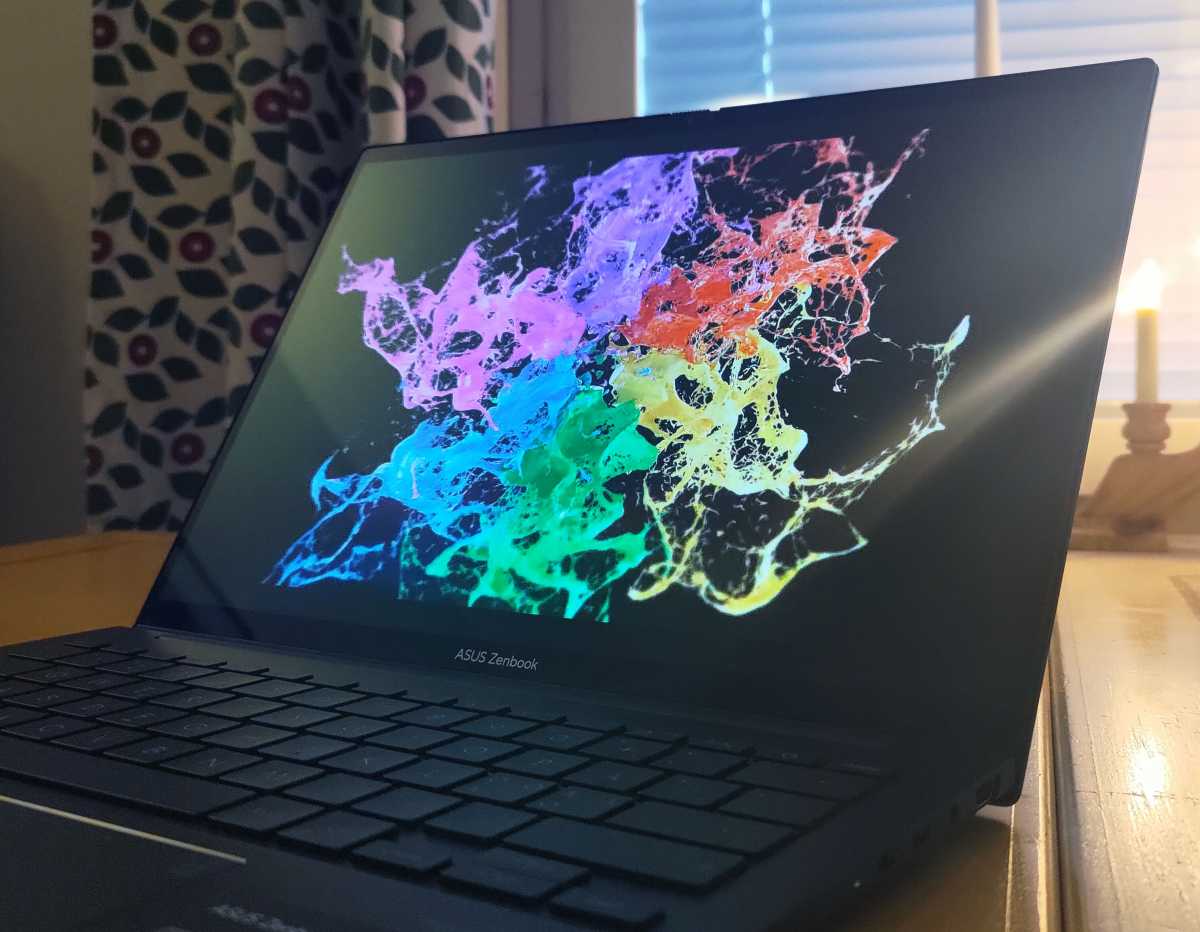 To avoid pixel burning, Asus has its own screensaver that can save the OLED panel.
To avoid pixel burning, Asus has its own screensaver that can save the OLED panel.
Mattias Inghe
Performance goes a long way if you want the computer to edit photos or video, especially this model, which is equipped with a full 32GB of RAM and a 1TB of fast SSD storage. And then, of course, there’s the new processor.
Asus Zenbook 14 OLED: New processor
Meteor Lake is the code name for a new generation of Intel Core processors for laptops. Apparently, Intel is abandoning the name Core i3, i5, i7 and i9. The processor inside this review unit r is called Core Ultra 7 155H. Core Ultra is more of an integrated SoC (System on Chip) than previous Intel processors and includes CPUs for AI, memory interfaces, IO controls, and more powerful graphics. Plus, it has a whopping 16 CPU cores.
Multi-threading is the future. Six of the cores (called Performance or P-core) are designed for high-performance and support hyperthreading, allowing for a maximum of 22 parallel operations. Of the remaining ten, eight are said to be semi-fast (Efficient or E-core) and two are extra power-efficient and slower (Low Power, LP-core).
The Core Ultra processors are intended to compete with AMD’s Ryzen 7000 series, at least the more efficient mobile ones with Zen4 architecture that appeared in computers during the summer and autumn. Powerful for thin laptops, both on the CPU and GPU side, and energy efficient.
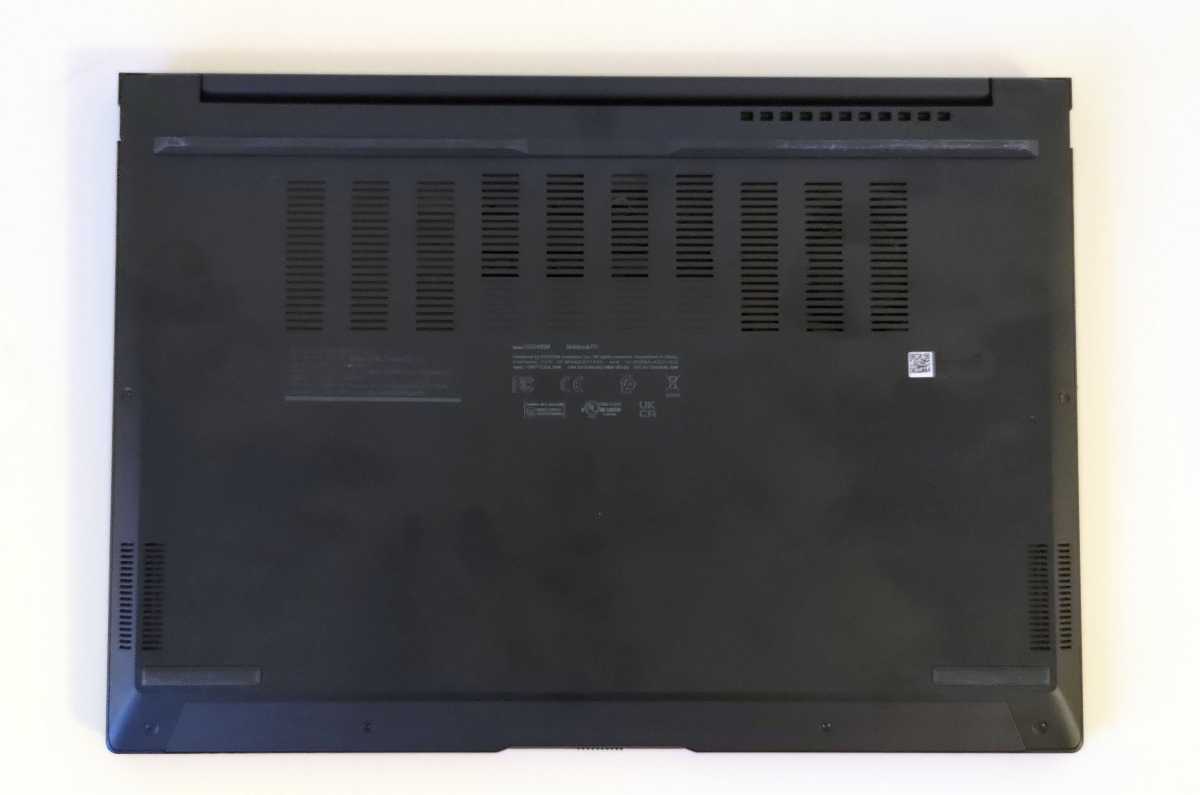 Clear grids for air intakes and speakers on the bottom.
Clear grids for air intakes and speakers on the bottom.
Mattias Inghe
Asus Zenbook 14 OLED: Not a huge boost, but faster
Benchmark measurements give a, well, cautious result. You’re not getting a revolution rather the same gradual improvement as between previous processor generations.
Compared to an Intel Core i7-1360P, perhaps the most common processor in this size class of computer from the last Intel generation, it’s a performance increase of between 10 and 30 percent depending on which computer I’m comparing with. It varied quite a lot in generation 13. But on average, performance is undeniably higher, if not enormously so.
Is that what you should compare it to or does the H at the end of the processor name mean it should be compared to the H-series of the 13th generation? The Core i7-13700H is a processor that on paper is close to the Core Ultra 7 155H, with an equal number of P cores and E cores. They pull very evenly in my measurements, with a few percent here and there, depending on the measurement program and time.
Finally, the question is how the Core Ultra 7 155H compares to what other manufacturers have to offer. It’s a bit faster on all points here than with AMD Ryzen 7 7840U, one of the few Zen 4 processors I’ve had the opportunity to test. But again, it’s a power-efficient U-series processor, so is it the right processor to match it with? Perhaps. According to Intel, the Core Ultra 7 155H only draws 28 watts. That’s not bad at all.
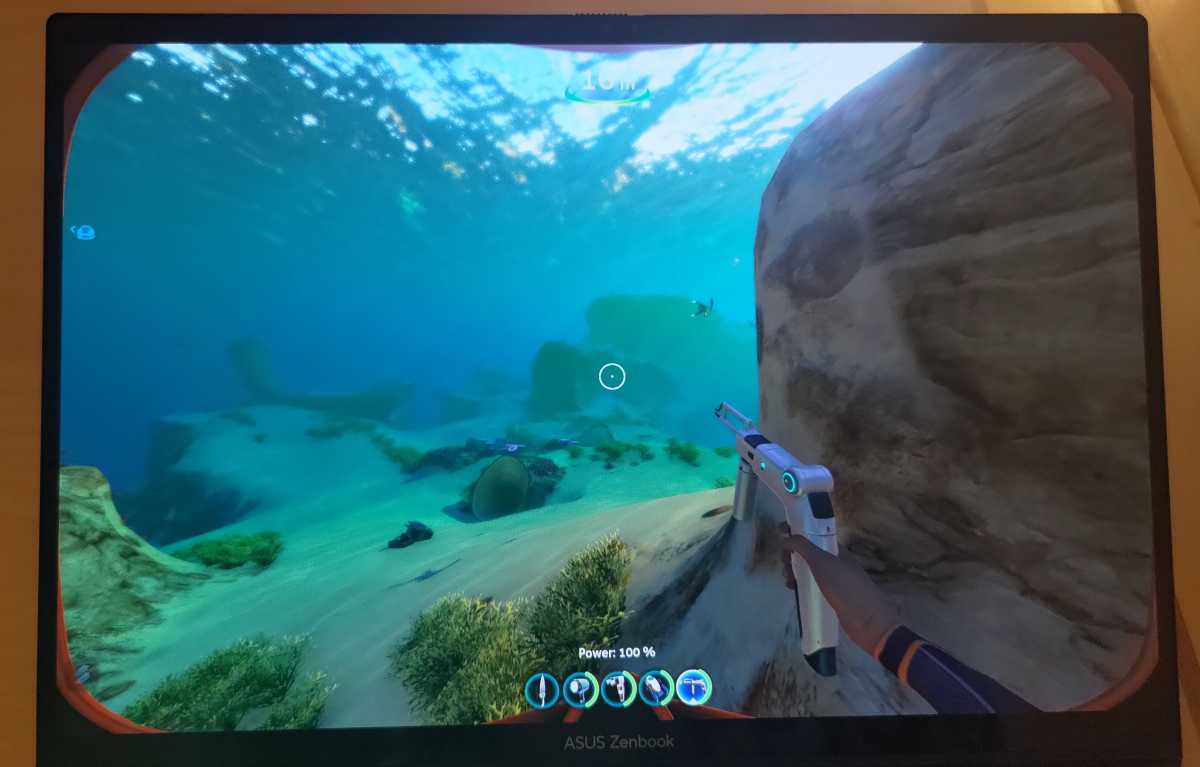 Intel Arc graphics provide perfectly acceptable gaming performance as long as you don’t have too high demands.
Intel Arc graphics provide perfectly acceptable gaming performance as long as you don’t have too high demands.
Mattias Inghe
Likewise, it’s about the same amount ahead of an Apple M3 according to test results from Geekbench and Cinebench. But it’s beaten by the M3 Max and M3 Ultra.
Asus Zenbook 14 OLED: Cooling, battery life
Can the Asus Zenbook 14 OLED compete in power efficiency, coolness, and battery life? Well, no. The Arm architecture has a big head start on those points. The computer can run partially on passive cooling, but you can expect fans, ranging from subtle whispering to obtrusive hissing, to start up.
Pure CPU and GPU measurements don’t tell the whole story of how good a processor is these days. There should also be built-in NPU powering AI, which helps with certain types of use, optimizing the computer at the system level.
How much battery life you get depends on many factors, mainly the screen and the battery itself. Powering such a fast and high-resolution OLED display can eat up energy. On the other hand, the battery here is relatively large, with a whopping 75 Wh capacity. Despite this, the computer is what we class as ultra-light.
I managed to get three and a half hours out of high processor load and full type brightness on the screen. The battery lasts even longer if I take it easy with the performance challenge and the screen. Working on the computer for an extended day should be fine without having to hunt down power outlets.
 Clear backlighting in the keys. Even clearer in the number “buttons” in the mouse pad.
Clear backlighting in the keys. Even clearer in the number “buttons” in the mouse pad.
Mattias Inghe
You also get a handy charger that connects with USB-C. With 65 watts of power, it charges the battery from 0-100 percent in less than two hours.
Asus Zenbook 14 OLED: Fast enough for gaming
The Apple M3 wins the graphics performance race by a wide margin, but the Intel Arc Graphics in this processor comes second to the Radeon 780M in AMD’s processor. The Radeon 780M is also found in Ryzen Z1 Extreme, which powers the handheld gaming computers ROG Ally and Lenovo Legion Go. It’s definitely powerful enough to make the Zenbook 14 Oled UX3405 a decent gaming PC for those who don’t have astronomical demands.
On paper at least, it may need some driver tuning to make all games run smoothly on it. The lack of dedicated graphics memory also means that some games have problems. I tried installing a couple of semi-demanding games and running them at 1080p resolution.
Subnautica runs smoothly with good fluidity between 50 and 70 fps while Horizon: Zero Dawn first complains about lack of video memory, then has trouble finding the right aspect ratio. It also doesn’t look good when I manually go in and force the game to render the image in the appropriate format. Perhaps it’s possible to get optimized drivers that solve this, but right out of the box there’s a lot to trim.
Asus Zenbook 14 OLED: Far from silent
If you set your computer’s fans to “Performance Mode”, you may notice aggressive hissing sounds as they power up to cool things down. You’ll need to up the volume to drown out the sound. Fortunately, you can squeeze out plenty of sound from the built-in speakers mounted on the bottom near the front edge. With Dolby Audio support and a Harman/Kardon sound system, the quality is high, although some of the finer details in the treble are missing.
Asus Zenbook 14 OLED: Specifications
Product name: Asus Zenbook 14 OLED UX3405MA-PURE16
Tested: December 2023
Manufacturer: Asus
Processor: Intel Core Ultra 7 155H, 6pcs P-core up to 4,8 GHz + 8pcs E-core, 2pcs LP-core
Graphics: Intel Arc Graphics
Memory: 32 GB ddr5
Storage: 1 TB ssd
Displays: 14 inch glossy oled, 2880×1800 pixels, 16:10, multitouch, 120 Hz
Webcam: 1080p with ir
Connections: 2pcs Thunderbolt 4, usb-a 3.0, hdmi 2.1, headset
Wireless: Wifi 6e, Bluetooth 5.3
Operating system: Windows 11 Home
Noise level: 0-39 dBa
Battery life: 75 Wh, 3 hrs 30 min (high load, full brightness), approx. 17 hrs (low load, low brightness)
Size: 31.2 x 22 x 1.5 cm
Weight: 2.82 pounds
Recommended retail price: $1,299.99
Asus Zenbook 14 OLED: Performance
Cinebecnh R23, multi-core CPU: 11,057 points
Cinebench R23, single core CPU: 1,726 points
Geekbench 6, multi-core CPU: 12,577 points
Geekbench 6, single core CPU: 2,378 points
Geekbench 6, GPU: 33,990 points
3DMark Fire Strike (DirectX 12): 6,063 points
3DMark Time Spy (DirectX 12): 2,871 points
Disk, read: up to 4,925.51 MB/s
Disk, write: up to 3,292.92 MB/s
This review was translated from Swedish to English and originally appeared on pcforalla.se.
>>> Read full article>>>
Copyright for syndicated content belongs to the linked Source : PCWorld – https://www.pcworld.com/article/2177124/asus-zenbook-14-oled-review-2.html































